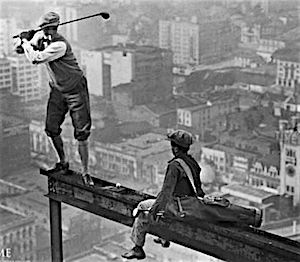
Neighbors in their early 70s invited us for drinks and hors d’oeuvres last Sunday afternoon. From the patio, we watched their poodles run through a two-acre orchard of adolescent black walnut trees. We ate sweet cherries, stuffed grape leaves, and toasted bread with cheese.
“Now tell me again,” said my neighbor, who works as a public health administrator, “why I shouldn’t worry about the size of the federal debt.”
Uncle Sam’s gargantuan finances are back in the news. Americans are confused. Only a few years ago, Congress complained that we’re condemning grandchildren to debt servitude. Yet, this summer, Congress and the President quietly raised the debt ceiling and added substantially to the annual budget deficit. A few legislators were angry, but not enough to make a difference.
As you’ve probably guessed by now, the debt is framed as an emergency only when politically useful. Our giant debt actually represents some good things, like personal savings and bank reserves. It’s a function of our trade deficit, and the fact that the dollar is the world’s reserve currency. The debt rescued the banks during the financial crisis. It re-inflated the stock market. The debt indicates that government has spent far more into the economy than it has taxed out, and many of us are the richer for it.
For the reasons listed below (with which you may strenuously disagree), I’ve chosen to stop worrying about the debt:
Reason 1. The debt is, in part, an inevitable result of running a big trade deficit. When the Chinese and others buy U.S. Treasuries, they use the dollars that we spent on their goods. Just as the Saudis recycled “petrodollars” to U.S. banks 40 years ago (creating a big mess), the Chinese recycle excess dollars to the U.S. by buying, among other things, Treasuries. As long as foreign exporters accept our currency for their goods, their countries will buy Treasuries. Is there a down side to running a big trade deficit? Yes. But that’s a different story.
Reason 2. One person’s debt is another person’s asset. We tend to forget that Treasury bonds aren’t merely liabilities. Under our system, oddly enough, government IOUs are money. The dollars in your pocket are Federal Reserve notes—just like Treasuries, except that they’re 100% liquid and pay no interest. To me, the U.S. debt, as assets, represents the market cap of the United States—much larger and less risky than the shares of a company like Apple or Facebook.
Reason 3. When we buy Treasuries or pay taxes, we’re financing the release of money into the U.S. economy. According to the Daily Treasury Statement for 8-1-2019, the U.S. Treasury’s “expenses” in the first nine months of 2019 included $765 billion in Social Security benefits, $288 billion in payments to defense contractors, $283 billion in IRS refunds, and $241.5 billion in interest to holders of Treasury securities. It also paid out about $1 trillion for Medicare, Medicare Advantage plans, and Medicaid, which becomes revenue for the private health care industry. Even if you don’t work for the government or receive direct government transfers, a chunk of your income consists of government spending (some of which was borrowed).
Reason 4. If not for the debt, the stock market wouldn’t be so high. The debt indicates that the government has spent about $22 trillion more into the private economy over the years than it has taxed out. That extra money has driven up the cost of almost everything we buy (by roughly a factor of 10, since 1967), including the prices of the stocks and homes we hold dear. It’s inconsistent to hate the debt but love the bull market. They’re two sides of the same coin.
Reason 5. That “debt clock” in the Wall Street Journal suggests that the U.S. is falling down a bottomless well of debt. Not exactly. According to the Daily Treasury Statement mentioned above, the U.S. Treasury has rolled over almost $10 trillion in marketable Treasury bills, note, bonds, TIPS, etc., so far this year. (It has rolled over an additional $64 trillion in non-marketable Government Account Series bonds.) The U.S. refinances some of its debt every day. It’s not delaying a $22 trillion tab into the future, where our grandchildren will be obligated to pick it up.
Reason 6. Private debt, not public debt, is the greater threat to financial stability. Uncle Sam has the big shoulders and longevity to carry much more debt for much longer than individuals or businesses do. Scare tactics about the federal debt strike me as an intentional distraction from the size of the private debt. Excess private debt caused the financial crisis; public debt resolved it. Fortunately, U.S. households are rich enough—with an estimated net worth of $108 trillion—to carry about $15.7 trillion in mortgage and consumer debt. But the market value of that wealth could change overnight, and the debt would still be there.
That’s more or less how I reassured my neighbors last week as we sat on their patio. They listened to these eccentric ideas more patiently than most people. But they’re unusual individuals. Twenty-four years ago they planted several long rows of black walnut saplings on their property as an investment. With careful pruning, the still-slender trees have grown tall and straight. They may or may not ever be worth much, but it’s soothing to watch them grow.
© 2019 RIJ Publishing LLC. All rights reserved.















